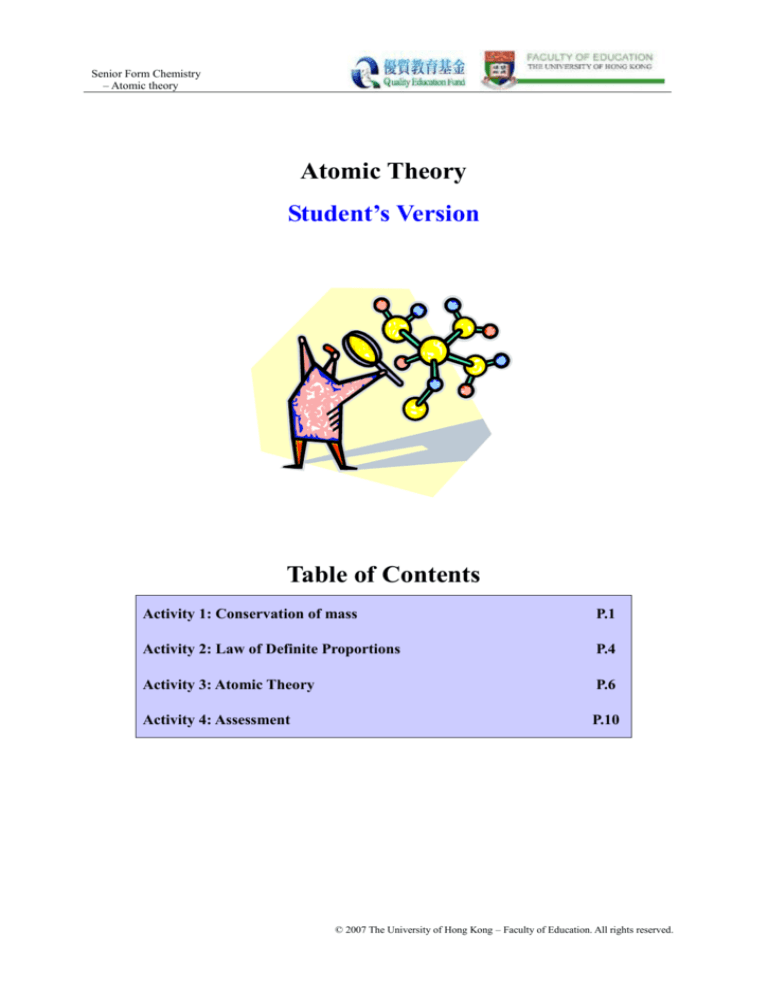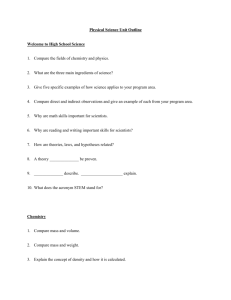
Senior Form Chemistry
– Atomic theory
Atomic Theory
Student’s Version
Table of Contents
Activity 1: Conservation of mass
P.1
Activity 2: Law of Definite Proportions
P.4
Activity 3: Atomic Theory
P.6
Activity 4: Assessment
P.10
© 2007 The University of Hong Kong – Faculty of Education. All rights reserved.
Senior Form Chemistry
– Atomic theory
Activity 1
Conservation of mass
When I eat a hamburger, will my
body mass increase by the mass of the
hamburger?
If a piece of magnesium is burnt, will there be a gain or a loss
in mass? Think about it!
Now divide into groups and conduct one of the following tasks to see whether there are
changes of mass. After the task, present your findings to your classmates.
1. Measure the mass of 500 cm3 of your
favourite drink. Then compare your body
mass before and after drinking it.
2. Compare the mass of sodium hydroxide
(NaOH) solution and copper(II) sulphate
(CuSO4) solution with the mass of the
mixture where we can see some
precipitate of Cu(OH) 2.
3. Dissolve 5 g table salt in 100 cm3 of water. Compare
the masses of solute, solvent and the resulting
solution.
P. 1
© 2007 The University of Hong Kong – Faculty of Education. All rights reserved.
Senior Form Chemistry
– Atomic theory
What can you conclude from the above investigations?
P. 2
© 2007 The University of Hong Kong – Faculty of Education. All rights reserved.
Senior Form Chemistry
– Atomic theory
Extension activity
The Law of Conservation of Mass was put forward by Antoine Lavoisier in 1774. Lavoisier is
known as the father of the modern chemistry. Find out more about his investigations!
Find evidence to answer the following questions in your project:
What were the major discoveries by Lavoisier?
How did he demonstrate the Law of Conservation of Mass?
Did he work alone in all his discoveries?
You can search for information from libraries or the internet. Here are three references:
1. http://www.pbs.org/wgbh/nova/einstein/ance-m.html(English only)
2. http://www.bud.org.tw/museum/s_star20.htm (Chinese only)
3. 多諾萬 (1997) 拉瓦謝: 化學改革與法國革命的先鋒。台北: 牛頓。
P. 3
© 2007 The University of Hong Kong – Faculty of Education. All rights reserved.
Senior Form Chemistry
– Atomic theory
Activity 2
Law of Definite Proportions
At the end of 1700s, scientists were trying very hard to discover laws or “regularities” in
Nature. Some chemists tried to mix different elements to see how they reacted with each
other. They could measure the mass of the reactants and products very accurately.
Here are some data, or experimental results, they obtained from the reaction of carbon with
oxygen to form carbon dioxide.
Mass of oxygen reacting (g)
Mass of carbon reacting (g)
32
12
64
24
96
36
Under some other conditions, carbon reacts differently with oxygen to produce carbon
monoxide. Here are the data for these reactions:
Mass of oxygen reacting (g)
Mass of carbon reacting (g)
16
12
32
24
48
36
Here are the data for the reaction between copper and oxygen:
P. 4
Mass of oxygen reacting (g)
Mass of copper reacting (g)
16
64
32
127
48
191
© 2007 The University of Hong Kong – Faculty of Education. All rights reserved.
Senior Form Chemistry
– Atomic theory
Can you discover any patterns in these data? Use your own words, draw a conclusion from
these experimental results.
P. 5
© 2007 The University of Hong Kong – Faculty of Education. All rights reserved.
Senior Form Chemistry
– Atomic theory
Activity 3
Atomic Theory
The Law of Conservation of Mass and the Law of Definite Proportion were great discoveries.
At that time, nobody could explain the laws. However, in about 1808, John Dalton proposed
the Atomic Theory which can be summarized by four points.
(a) All matter is composed of very small discrete particles.
(b) For elements, the particles are called atoms and are indivisible and indestructible in
chemical reactions.
(c) (i) Each atom of a given element has the same mass. (ii) All atoms of a given element are
identical. (iii) The masses of atoms of different elements are different.
(d) A chemical compound is formed from its elements by the combination of the different
atoms in a fixed ratio for that compound.
How can this theory explain the Law of Conservation of Mass and the Law of Definite
Proportions with reference to activities 1 and 2? Discuss with your classmates.
P. 6
© 2007 The University of Hong Kong – Faculty of Education. All rights reserved.
Senior Form Chemistry
– Atomic theory
What are the differences between a law and a theory?
In your daily lives, you may be familiar with the law below:
Thermal expansion and contraction
(熱脹冷縮)
Does the law explain the behavior of a material (e.g. a gas) in different temperature? Explain
your answer.
You may have also learnt:
Angle of incidence, θi = Angle of reflection, θr
Is it a law or a theory? Explain.
P. 7
© 2007 The University of Hong Kong – Faculty of Education. All rights reserved.
Senior Form Chemistry
– Atomic theory
Can you give some others examples of laws and theories that you have learnt?
P. 8
© 2007 The University of Hong Kong – Faculty of Education. All rights reserved.
Senior Form Chemistry
– Atomic theory
Extension activity: (The tentative nature of the atomic theory)
In Activity 3, you read about Dalton’s Atomic Theory. Comment on the theory with reference
to your knowledge in Chemistry.
Atomic Theory
(a) All matter is composed of very small discrete particles.
(b) For elements, the particles are called atoms and are indivisible and indestructible in
chemical reactions.
(c) Each atom of a given element has the same mass. (ii) All atoms of a given element are
identical. (iii) The masses of atoms of different elements are different.
(d) A chemical compound is formed from its elements by the combination of the different
atoms in a fixed ratio for that compound.
P. 9
© 2007 The University of Hong Kong – Faculty of Education. All rights reserved.
Senior Form Chemistry
– Atomic theory
Activity 4
Assessment
1. Discuss with your neighbours. Please tick the appropriate box.
True
False
Don’t
know
(a) The mass of an iron atom in a hammer is greater
than the mass of an iron atom in a nail.
(b) When you change a piece of solid copper into the
liquid state, the mass of each copper atom
decreases.
(c) When you heat a silver ring, it expands. This is
because the silver atoms become bigger.
2. If you took all of the atoms out of a chair, what would be left? (Circle your answer.)
A.
B.
C.
D.
P. 10
The chair would still be there, but it would weigh less.
The chair would be exactly the same as it was before.
There would be nothing left of the chair.
Only a pool of liquid would be left on the floor.
© 2007 The University of Hong Kong – Faculty of Education. All rights reserved.
Senior Form Chemistry
– Atomic theory
3. The picture shows some iron atoms on the surface of a piece of iron. When iron rusts,
oxygen atoms react with the iron atoms.
(a) What will be the difference in masses between the iron, compared to the rusted iron?
(Circle your answer.)
A.
B.
C.
The iron is heavier than the rusted iron.
The rusted iron is heavier than the iron.
They have the same mass.
(b) Draw a picture to show what the piece of rusted iron would look like if you could see the
atoms.
P. 11
© 2007 The University of Hong Kong – Faculty of Education. All rights reserved.
Senior Form Chemistry
– Atomic theory
4. Compare the mass of the setup before and after CuSO4 crystals have grown.
Explain your answer.
5. Compare the masses of 355cm3 diet coke and 355cm3 regular coke after pouring them out
of the cans. Discuss whether this is related to the Law of Conservation of Mass or not.
P. 12
© 2007 The University of Hong Kong – Faculty of Education. All rights reserved.








